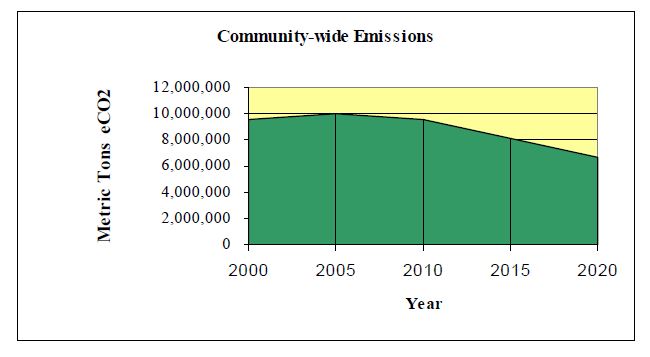
Jurisdiction: Kansas City, Missouri
Plan Year: 2008
Background:
In August 2006, Kansas City’s Mayor and City Council, City Manager, and Chief Environmental Officer decided to develop a communitywide climate protection plan. By October 2006, the Mayor had appointed an 11-member Steering Committee to oversee the planning process. Other stakeholders included local businesses, Mid-America Regional Council (MARC) staff, Environmental Management Commission, environmental and other non-profit organizations, local neighborhoods, and the EPA, State of Missouri, Jackson County, and City staff.
Work groups were created in November 2006 to develop suggested action plans in specific areas:
- Energy
- Transportation
- Carbon Offsets and Waste Management
- Policy and Outreach
In April 2007, Kansas City adopted Phase 1 of the Climate Protection Plan, and created four Working Groups to develop recommendations for the Steering Committee regarding government goals. Phase 2 was created in July 2008 and consisted of two Working Groups convened to produce recommendations for community-wide action and objectives, including developing a baseline inventory and establishing a GHG reduction goal.
The CAP includes overall emission reduction goals of the following:
- By 2010: City reduce emissions by 10% from 2000 levels; Community reduce emissions to 2000 levels
- By 2015: City reduce emissions by 20% from 2000 levels; Community reduce emissions by 15% from 2000 levels
- By 2020: City reduce emissions by 30% from 2000 levels; Community reduce emissions by 30% from 2000 levels
- By 2050: City and community reduce emissions by 80% from 2000 levels
Materials Management Goals:
- Reduce community-wide GHG emissions by 80% by 2050
- Achieve an 80% diversion rate of organic material (buildings and infrastructure)
Strategies:
Kansas City’s Carbon Offsets and Waste Management Work Group included several sustainable materials management strategies in its recommendations. The total annual emissions reductions for this work group (including some strategies unrelated to materials management, such as expanding the city’s urban forestry program) were 40,600 metric tons for the City’s actions, and 183,525 metric tons for the community.
- Develop a comprehensive solid waste management plan
- Increase and expand curbside recycling program
- Expand city government recycling and green purchasing
- Make construction and demolition recycling mandatory for city-support projects
The Buildings & Infrastructure Work Group included a “No Waste” component that estimated possible emissions reductions of 1,000 metric tons for the City and 109,210 metric tons for the community. Their strategy recommendation included:
- Reorganize the Solid Waste Management Division of Public Works into a Resource Recovery Management Department
- Develop a Regional Resource Recovery and Management Facility and Environmental Campus
- Manage and reduce construction and demolition waste to achieve an 80% diversion rate
Progress Report:
- None available at this time.
Next Steps:
At the time of this writing, Kansas City was updating its GHG emissions inventory with 2013 data.
Links:
